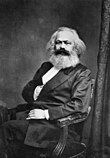
Back مبرهنة أوكيشيو Arabic Okishio-Theorem German Teorema de Okishio Spanish Théorème d'Okishio French Teoremat Okishio Polish
| Part of a series on |
| Marxian economics |
|---|
 |
Okishio's theorem is a theorem formulated by Japanese economist Nobuo Okishio. It has had a major impact on debates about Marx's theory of value. Intuitively, it can be understood as saying that if one capitalist raises his profits by introducing a new technique that cuts his costs, the collective or general rate of profit in society goes up for all capitalists. In 1961, Okishio established this theorem under the assumption that the real wage remains constant. Thus, the theorem isolates the effect of pure innovation from any consequent changes in the wage.
For this reason the theorem, first proposed in 1961, excited great interest and controversy because, according to Okishio, it contradicts Marx's law of the tendency of the rate of profit to fall.[citation needed] Marx had claimed that the new general rate of profit, after a new technique has spread throughout the branch where it has been introduced, would be lower than before. In modern words, the capitalists would be caught in a rationality trap or prisoner's dilemma: that which is rational from the point of view of a single capitalist, turns out to be irrational for the system as a whole, for the collective of all capitalists. This result was widely understood, including by Marx himself, as establishing that capitalism contained inherent limits to its own success. Okishio's theorem was therefore received in the West as establishing that Marx's proof of this fundamental result was inconsistent.
More precisely, the theorem says that the general rate of profit in the economy as a whole will be higher if a new technique of production is introduced in which, at the prices prevailing at the time that the change is introduced, the unit cost of output in one industry is less than the pre-change unit cost. The theorem, as Okishio (1961:88) points out, does not apply to non-basic branches of industry.
The proof of the theorem may be most easily understood as an application of the Perron–Frobenius theorem. This latter theorem comes from a branch of linear algebra known as the theory of nonnegative matrices. A good source text for the basic theory is Seneta (1973). The statement of Okishio's theorem, and the controversies surrounding it, may however be understood intuitively without reference to, or in-depth knowledge of, the Perron–Frobenius theorem or the general theory of nonnegative matrices.
© MMXXIII Rich X Search. We shall prevail. All rights reserved. Rich X Search